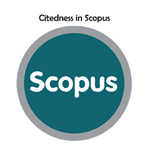Skrining Studi in Silico Potensi Farmakokinetika dan Toksisitas Senyawa 6,10,14-trimetil-2-pentadekanon dari Ekstrak Daun Ekaliptus
Abstract
Keywords
Full Text:
PDFReferences
. Lusi LRHDFWA. Uji Aktivitas Antibakteri Ekstrak Daun Kelor (Moringa Oleifera L.) Terhadap Bakteri Escherichia Coli Dan Staphylococcus Aureus. Pharmacon. 2016;5(2):282-9.
. Yuslianti ER, Bachtiar BM, Suniarti DF, Sutjiatmo AB. Natural Products Pharmaceutical Standardization Towards Phytopharmaca for Indonesian Traditional Medicine Development. Dentika Dent J. 2016;19(2):179-85.
. Muhaimin M, Ningsih KN, Latief M. Senyawa Turunan Terpenoid dari Ekstrak Aseton Daun Perepat (Sonneratia alba) dan Aktivitasnya Terhadap Escherichia coli. J Indones Soc Integr Chem. 2021 Sep;13(2):75-83.
. Terpenoida S, Steroida DAN. Senyawa terpenoida dan steroida. 2006;
. Mierza V, Ichsani A, Sridevi A. Research Article : Isolasi dan Identifikasi Senyawa Terpenoid Research Article : Isolation and Identification of Terpenoid Compounds.
. Perdana F, Ws D, Rd R. Penapisan fitokimia dan uji aktivitas antioksidan ekstrak metanol daun jambu bol (Syzygium malaccense (L.) Merr. & Perry), daun salam (Syzygium polyanthum (Wight.) Walpers), serta daun jamblang (Syzygium cumini (L.) Skeels) asal arboretum garut. J Ilm Farm Bahari. 2018;7(2):22-30.
. Kesuma D, Siswandono S, Purwanto BT, Hardjono S. Uji in silico Aktivitas Sitotoksik dan Toksisitas Senyawa Turunan N-(Benzoil)-N'- feniltiourea Sebagai Calon Obat Antikanker. JPSCR J Pharm Sci Clin Res. 2018;3(1):1.
. Marin DE, Taranu I. Using In Silico Approach for Metabolomic and Toxicity Prediction of Alternariol. 2023;
. Merdekawati F. In silico toxicity prediction of 1-phenyl-1- ( quinazolin-4-yl ) ethanol compounds by using Toxtree , pkCSM and preADMET. 2018;8(2).
. Wilapangga A. Analisis Potensi Farmakokinetik dan Toksisitas Pada Curcumin ( Curcuma xanthorrhiza ) Sebagai Brightening Terhadap Reseptor Protein Tirosinase Secara in Silico. 2023;3(2):203-11.
. Sari SW, Wilapangga A, Sari AN, Astriani S. Studi In Silico Potensi Farmakokinetik Dua Senyawa Dari Tanaman Kenaf ( Hibiscus cannabinus L .) Untuk Prediksi Toksisitas. 2023;XIX(2):70-9.
. Kesehatan J, Science D, Febri FA, Chilfi T, Putri M, Salamah AF. Jurnal Bina Cipta Husada Vol . XIX , No . 1 2023 ANALISIS FARMAKOKINETIK DAN TOKSISITAS PADA KANDUNGAN FENOLIK EKSTRAK DAUN SALAM ( Syzygium polyanthum ) MENGGUNAKAN IN SILICO pkCMS DAN PROTOX II. 2023;XIX(1):108-17.
. Kesehatan J, Science D, Issn I. STUDI IN SILICO POTENSI FARMAKOKINETIK TUJUH SENYAWA DARI TUMBUHAN BROTOWALI ( Tinospora cordifolia ) UNTUK. 2023;XIX(2):101-11.
. Aktivitas DAN, Brazilein I. Journal of Indonesian Medical Laboratory and Science. 2020;1(1):76-90.
. Nursanti O, Farmasi PS, Militer FF, Pertahanan U, Indonesia R. PREDIKSI TOKSISITAS DAN FARMAKOKINETIKA UNTUK MENDAPATKAN. 2023;3(2):1-9.
DOI: https://doi.org/10.37311/ijpe.v4i1.24493
Refbacks
- There are currently no refbacks.
Copyright (c) 2024 Anjas - wilapangga

Indonesian Journal of Pharmaceutical Education is licensed under a Creative Commons Attribution-NonCommercial-ShareAlike 4.0 International License.



